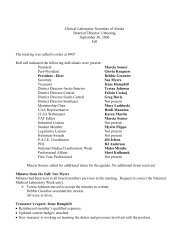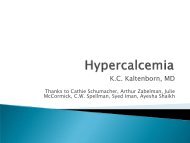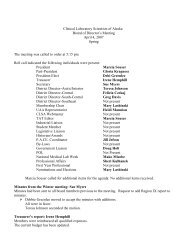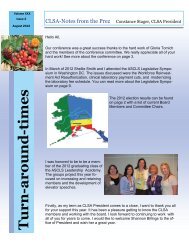The Use of NT-proBNP and BNP as Biomarkers of Acute Heart Failure
The Use of NT-proBNP and BNP as Biomarkers of Acute Heart Failure
The Use of NT-proBNP and BNP as Biomarkers of Acute Heart Failure
Create successful ePaper yourself
Turn your PDF publications into a flip-book with our unique Google optimized e-Paper software.
<strong>The</strong> <strong>Use</strong> <strong>of</strong> <strong>NT</strong>-<strong>pro<strong>BNP</strong></strong> <strong>and</strong> <strong>BNP</strong> <strong>as</strong><br />
<strong>Biomarkers</strong> <strong>of</strong> <strong>Acute</strong> <strong>Heart</strong> <strong>Failure</strong><br />
John Backus, Ph.D.<br />
Director, Scientific Affairs<br />
© Ortho-Clinical Diagnostics, Inc.
Presentation Outline<br />
•B-Type Natriuretic Peptides <strong>BNP</strong> & <strong>NT</strong>-<strong>pro<strong>BNP</strong></strong><br />
•B-type Natriuretic Peptide Biology<br />
•<strong>Use</strong> <strong>of</strong> <strong>BNP</strong> in the <strong>Acute</strong> Setting<br />
•Potential benefits <strong>of</strong> <strong>NT</strong>-<strong>pro<strong>BNP</strong></strong><br />
•Non-HF Sources <strong>of</strong> Elevated <strong>NT</strong>-<strong>pro<strong>BNP</strong></strong> (<strong>and</strong> <strong>BNP</strong>)<br />
•<strong>Use</strong> <strong>of</strong> <strong>NT</strong>-<strong>pro<strong>BNP</strong></strong> in the <strong>Acute</strong> Setting<br />
•Other Clinical Utilities <strong>of</strong> <strong>NT</strong>-<strong>pro<strong>BNP</strong></strong><br />
© Ortho-Clinical Diagnostics, Inc.
B-type Natriuretic Peptides<br />
Pre-Pro-<strong>BNP</strong> 1-134<br />
26-aa signal<br />
sequence<br />
Pro-<strong>BNP</strong> 1-108<br />
WALL<br />
STRESS<br />
N-terminal<br />
Pro-<strong>BNP</strong> 1-76<br />
t 1/2 = 60-120 min<br />
<strong>BNP</strong> 77-108<br />
t 1/2 = 18 min<br />
Source: Medscape.com (10/12/2009)<br />
3
<strong>Use</strong> <strong>of</strong> <strong>BNP</strong> Assay<br />
• “…useful in establishing or excluding the diagnosis <strong>of</strong><br />
CHF in patients with acute dyspnea.”<br />
• 100 pg/ml cut<strong>of</strong>f (for ruling out)<br />
• 90 % sensitivity<br />
• 76% specificity<br />
• 89% NPV<br />
• <strong>BNP</strong> > 500 pg/ml PPV=90%<br />
• Grey zone 100pg/ml-500pg/ml where there are a<br />
number <strong>of</strong> conditions that could cause incre<strong>as</strong>ed levels<br />
Source: Maisel et al, New Eng J Med (2002) 347:161-167.<br />
4
“Breathing Not Properly” Multinational Study<br />
Source: Maisel et al, New Eng J Med (2002) 347:161-167.<br />
5
B-Type Natriuretic Peptide<br />
“…<strong>BNP</strong> concentrations are higher in females <strong>and</strong><br />
incre<strong>as</strong>e with incre<strong>as</strong>ing age…Given that HF is,<br />
to a large extent, a dise<strong>as</strong>e <strong>of</strong> the aging <strong>and</strong> that<br />
the prevalence <strong>of</strong> HF in younger groups is low<br />
compared with age groups >55, it is likely that<br />
the use <strong>of</strong> age- <strong>and</strong> gender-related cut<strong>of</strong>fs will<br />
improve the clinical sensivity <strong>of</strong> all <strong>BNP</strong> <strong>as</strong>says<br />
while maintaining a high specificity.”<br />
Source: Wu et. Al, Clin Chem (2004) 50:867-873.<br />
6
ValHeft Study: 2006<br />
LVEF: left ventricular ejection fraction<br />
LVIDd: left ventricular diameter in di<strong>as</strong>tole<br />
Source: M<strong>as</strong>son et al, Clin Chem (2006) 52:1528-1538.<br />
7
An <strong>NT</strong>-<strong>pro<strong>BNP</strong></strong> cut-point <strong>of</strong> 900 pg/mL Performs<br />
Similarly to a <strong>BNP</strong> cut-point <strong>of</strong> 100 pg/mL<br />
PRIDE (<strong>NT</strong>-<strong>pro<strong>BNP</strong></strong>)<br />
Breathing Not Properly (<strong>BNP</strong>)<br />
Sources: Januzzi et al, Eur <strong>Heart</strong> J (2006) 27: 839-845.<br />
Maisel et al, New Eng J Med (2002) 347:161-167.<br />
8
<strong>NT</strong>-<strong>pro<strong>BNP</strong></strong> Levels by Diagnosis<br />
in Patients with <strong>Acute</strong> Dyspnea<br />
Source: Januzzi et al, - Eur <strong>Heart</strong> J (2006) 27: 330-337.<br />
9
Why <strong>NT</strong>-<strong>pro<strong>BNP</strong></strong><br />
I. <strong>NT</strong>-<strong>pro<strong>BNP</strong></strong> is more stable than <strong>BNP</strong>*<br />
Mean recovery <strong>of</strong> <strong>BNP</strong> w<strong>as</strong> less than 70% after one day <strong>of</strong> storage at –20°C <strong>and</strong><br />
decre<strong>as</strong>ed to less than 50% after two to four months <strong>of</strong> storage<br />
II.<br />
III.<br />
IV.<br />
<strong>NT</strong>-<strong>pro<strong>BNP</strong></strong> values are generally more precise**<br />
<strong>NT</strong>-<strong>pro<strong>BNP</strong></strong> <strong>as</strong>says have shown excellent within run <strong>and</strong> total precision with total CV<br />
ranging from 2.9% to 6.1%. In contr<strong>as</strong>t, total CV for <strong>BNP</strong> ranged from 9.9% to 12.5%,<br />
which is approximately 2-3 fold higher than the <strong>NT</strong>-<strong>pro<strong>BNP</strong></strong> method.<br />
<strong>NT</strong>-<strong>pro<strong>BNP</strong></strong> is a better predictor <strong>of</strong> patient outcomes***<br />
<strong>NT</strong>-<strong>pro<strong>BNP</strong></strong> w<strong>as</strong> superior to <strong>BNP</strong> for predicting mortality <strong>and</strong> morbidity (P=0.032) or<br />
hospitalization for HF (P=0.0143)<br />
<strong>NT</strong>-<strong>pro<strong>BNP</strong></strong> <strong>as</strong>says are harmonized****<br />
Common source <strong>of</strong> antibodies (Roche)<br />
Age-related cut <strong>of</strong>f values established<br />
Sources: * Mueller et al, Clin Chem Lab Med (2004) 42:942-944.<br />
** Yeo et al, Clin Chim Acta (2003) 338:107-15.<br />
*** M<strong>as</strong>son et al, Clin Chem (2006) 52:1528-38 .<br />
**** Januzzi et al, Am J Cardiol (2008) 101: 9A-15A.<br />
10
VITROS ® <strong>NT</strong>-<strong>pro<strong>BNP</strong></strong> – Method Comparison<br />
<strong>NT</strong>-<strong>pro<strong>BNP</strong></strong><br />
– Adopted in Clinical Practice Guidelines<br />
– Optimal accuracy <strong>and</strong> precision<br />
– Method Comparison: Demonstrates<br />
excellent agreement across me<strong>as</strong>uring<br />
range<br />
Source : Pub. No. GEM1315_EN_US Version 4.0<br />
Trademarks not owned by Ortho Clinical Diagnostics<br />
are the property <strong>of</strong> their respective owners<br />
11
Potential Causes <strong>of</strong> <strong>NT</strong>-<strong>pro<strong>BNP</strong></strong> Elevation<br />
Source:<br />
Januzzi et al, - Am J Cardiol (2008) 101: 29A-38A.<br />
12
<strong>NT</strong>-<strong>pro<strong>BNP</strong></strong> in the <strong>Acute</strong> Setting<br />
13
ICON Study Group:<br />
James Januzzi, Aaron Baggish (Boston)<br />
Antoni Bayes-Genis (Barcelona)<br />
Rol<strong>and</strong> RJ van Kimmenade, Yigal Pinto (Ma<strong>as</strong>tricht)<br />
A. Mark Richards, John Lainchbury (Christchurch)<br />
Source: Januzzi et al, Eur <strong>Heart</strong> J (2006) 27: 839-845.<br />
14
<strong>NT</strong>-<strong>pro<strong>BNP</strong></strong> Levels by Diagnosis<br />
in Patients with <strong>Acute</strong> Dyspnea<br />
Source: Januzzi et al, - Eur <strong>Heart</strong> J (2006) 27: 330-337.<br />
15
<strong>NT</strong>-<strong>pro<strong>BNP</strong></strong> Levels in <strong>Acute</strong> <strong>Heart</strong> <strong>Failure</strong><br />
<strong>as</strong> a Function <strong>of</strong> <strong>Heart</strong> <strong>Failure</strong> Severity<br />
Source: Januzzi et al, - Eur <strong>Heart</strong> J (2006) 27: 330-337.<br />
16
<strong>NT</strong>-<strong>pro<strong>BNP</strong></strong> Levels Predict Survival<br />
in Patients with <strong>Acute</strong> <strong>Heart</strong> <strong>Failure</strong><br />
Source: Januzzi et al, - Eur <strong>Heart</strong> J (2006) 27: 330-337.<br />
17
Elevated <strong>NT</strong>-<strong>pro<strong>BNP</strong></strong> <strong>and</strong> Impaired Renal<br />
Function Predict Poor Outcome in <strong>Acute</strong> HF<br />
Source:<br />
Baggish et al, - Am J Cardiol (2008) 101: 49A-55A.<br />
18
Age-independent Rule-out Cut-point<br />
• International Collaborative <strong>of</strong> <strong>NT</strong>-<strong>pro<strong>BNP</strong></strong> (ICON) Study data (acute setting):<br />
• 300 pg/ml, age independent<br />
• 99% sensitive<br />
• 60% specific<br />
• 98% NPV<br />
Source: Januzzi et al, Eur <strong>Heart</strong> J (2006) 27: 839-845.<br />
19
Age-stratified Rule-in Cut-points<br />
• International Collaborative <strong>of</strong> <strong>NT</strong>-<strong>pro<strong>BNP</strong></strong> (ICON) Study data (acute setting):<br />
To Diagnose <strong>Acute</strong> <strong>Heart</strong> <strong>Failure</strong><br />
Age strata<br />
All 75 years<br />
1800 pg/ml<br />
85%<br />
73%<br />
92%<br />
55%<br />
83%<br />
*Very superior to single cut-point strategy in multivariable bootstrapping models<br />
Source: Januzzi et al, Eur <strong>Heart</strong> J (2006) 27: 839-845.<br />
20
<strong>NT</strong>-<strong>pro<strong>BNP</strong></strong> vs <strong>BNP</strong> for <strong>Acute</strong> <strong>Heart</strong> <strong>Failure</strong><br />
General Summary<br />
• Individuals with heart failure typically have approximately 8-10X higher<br />
levels <strong>of</strong> <strong>NT</strong>-<strong>pro<strong>BNP</strong></strong> versus <strong>BNP</strong>.<br />
• Close to half <strong>of</strong> this difference is due to the difference in molecular weight <strong>of</strong> the two molecules<br />
(<strong>NT</strong>-<strong>pro<strong>BNP</strong></strong> is about 2.5X larger than <strong>BNP</strong>).<br />
• <strong>The</strong> rest is likely due to the fact that <strong>NT</strong>-<strong>pro<strong>BNP</strong></strong> h<strong>as</strong> higher in vivo stability.<br />
• As an aid in the diagnosis <strong>of</strong> acute heart failure, a single <strong>NT</strong>-<strong>pro<strong>BNP</strong></strong><br />
cut-point <strong>of</strong> 900 pg/mL <strong>of</strong>fers performance essentially equivalent to a<br />
<strong>BNP</strong> cut-point <strong>of</strong> 100 pg/mL.<br />
• <strong>The</strong> ICON triple “rule-in” <strong>NT</strong>-<strong>pro<strong>BNP</strong></strong> cutpoints for acute heart failure<br />
(age-specific cutpoints <strong>of</strong> 450, 900, <strong>and</strong> 1800 pg/mL) are designed to<br />
account for the impacts <strong>of</strong> age <strong>and</strong> renal function<br />
• Both <strong>BNP</strong> <strong>and</strong> <strong>NT</strong>-<strong>pro<strong>BNP</strong></strong> incre<strong>as</strong>e with incre<strong>as</strong>ing age <strong>and</strong> decre<strong>as</strong>ing renal function.<br />
• <strong>The</strong> ICON triple <strong>NT</strong>-<strong>pro<strong>BNP</strong></strong> cutpoints are designed to provide similar information, but with better<br />
performance, relative to the <strong>BNP</strong> cut-point <strong>of</strong> 100 pg/mL.<br />
• Relative to <strong>BNP</strong>, <strong>NT</strong>-<strong>pro<strong>BNP</strong></strong> also <strong>of</strong>fers the benefits <strong>of</strong> platform<br />
harmonization <strong>and</strong> enhanced analyte stability, both in vitro <strong>and</strong> in vivo<br />
Source:<br />
Januzzi et al. Am. J. Cardiol 2008; 101: 29A-38A.<br />
21
Other Clinical Utilities <strong>of</strong> <strong>NT</strong>-<strong>pro<strong>BNP</strong></strong><br />
22
VITROS ® <strong>NT</strong>-<strong>pro<strong>BNP</strong></strong> – Intended <strong>Use</strong><br />
Source : Pub. No. GEM1315_EN_US Version 4.0<br />
© Ortho-Clinical Diagnostics, Inc.<br />
23
<strong>NT</strong>-<strong>pro<strong>BNP</strong></strong> Decision Thresholds<br />
Defined in Individuals With No <strong>Acute</strong> Symptoms<br />
Source : Pub. No. GEM1315_EN_US Version 4.0<br />
© Ortho-Clinical Diagnostics, Inc.<br />
24
<strong>NT</strong>-<strong>pro<strong>BNP</strong></strong>-Tailored CHF <strong>The</strong>rapy<br />
<strong>The</strong> PROTECT Trial <strong>as</strong> an Example<br />
Source:<br />
Bhardwaj et al. Am <strong>Heart</strong> J 2010;159: 532-538.e1.<br />
25
Inclusion/Exclusion Criteria<br />
Inclusion Criteria<br />
• Age > 21 years <strong>of</strong> age<br />
• Left ventricular ejection fraction ≤ 40%<br />
• New York <strong>Heart</strong> Association cl<strong>as</strong>s II-IV symptoms<br />
• Hospitalization, ED visit, or outpatient therapy for ADHF within 6 months<br />
Exclusion criteria<br />
• Serum creatinine > 2.5 mg/dl<br />
• Inoperable aortic valve dise<strong>as</strong>e<br />
• Life expectancy
Study Endpoints<br />
•1 endpoint<br />
•Total cardiov<strong>as</strong>cular<br />
events*<br />
• Worsening HF †<br />
• HF hospitalization<br />
• ACS<br />
• Ventricular arrhythmia<br />
• Cerebral ischemia<br />
• Cardiov<strong>as</strong>cular death<br />
•2 endpoints<br />
•Quality <strong>of</strong> life<br />
•Changes in echo<br />
parameters<br />
• LV ejection fraction<br />
• LVESVi<br />
• LVEDVi<br />
*Assessed using generalized estimating equations<br />
†<br />
Requiring at le<strong>as</strong>t 2 from the following: symptoms <strong>of</strong> congestion or falling cardiac output,<br />
signs <strong>of</strong> new congestion on exam, use <strong>of</strong> “bail out” decongestive therapy, or rising <strong>NT</strong>-<strong>pro<strong>BNP</strong></strong><br />
in the un-blinded arm<br />
Source: Januzzi et al. clinicaltrialresults.org/Slides/PROTECT%20Presentation%20FINAL.ppt, accessed March 27, 2012<br />
27
<strong>NT</strong>-<strong>pro<strong>BNP</strong></strong> Concentrations<br />
B<strong>as</strong>eline Follow-up P<br />
Overall 2118 1321 .02<br />
By treatment allocation<br />
Treatment B<strong>as</strong>eline Follow-up P<br />
SOC 1946 1844 .61<br />
<strong>NT</strong>-<strong>pro<strong>BNP</strong></strong> 2344 1125 .01<br />
P = .03 for SOC follow-up versus <strong>NT</strong>-<strong>pro<strong>BNP</strong></strong> follow-up<br />
44.3% <strong>of</strong> <strong>NT</strong>-<strong>pro<strong>BNP</strong></strong> subjects 1000 pg/mL<br />
Source: Januzzi et al. clinicaltrialresults.org/Slides/PROTECT%20Presentation%20FINAL.ppt, accessed March 27, 2012<br />
28
Primary Endpoint<br />
100 events<br />
P =.009<br />
SOC<br />
<strong>NT</strong>-<strong>pro<strong>BNP</strong></strong><br />
58 events<br />
*Logistic Odds <strong>NT</strong>-<strong>pro<strong>BNP</strong></strong> = 0.44<br />
(95% CI= .22-.84; P =.019)<br />
*Adjusted for age, LVEF, NYHA Cl<strong>as</strong>s, <strong>and</strong> eGFR<br />
Source: Januzzi et al. clinicaltrialresults.org/Slides/PROTECT%20Presentation%20FINAL.ppt, accessed March 27, 2012<br />
29
Mean number <strong>of</strong> events<br />
Age <strong>and</strong> outcomes<br />
SOC<br />
<strong>NT</strong>-<strong>pro<strong>BNP</strong></strong><br />
P =.008 P =.005<br />
Age < 75 years<br />
Age ≥ 75 years<br />
*No interaction between age <strong>and</strong> <strong>NT</strong>-<strong>pro<strong>BNP</strong></strong> guided care w<strong>as</strong> found (P =.11)<br />
Source: Januzzi et al. clinicaltrialresults.org/Slides/PROTECT%20Presentation%20FINAL.ppt, accessed March 27, 2012<br />
30
Events <strong>as</strong> a function <strong>of</strong> <strong>NT</strong>-<strong>pro<strong>BNP</strong></strong><br />
P 3000 pg/mL<br />
Achieved <strong>NT</strong>-<strong>pro<strong>BNP</strong></strong> value<br />
Source: Januzzi et al. clinicaltrialresults.org/Slides/PROTECT%20Presentation%20FINAL.ppt, accessed March 27, 2012<br />
31
PROTECT: Summary<br />
•<strong>NT</strong>-<strong>pro<strong>BNP</strong></strong> guided care w<strong>as</strong> superior to SOC<br />
management for the reduction <strong>of</strong> total cardiov<strong>as</strong>cular<br />
events.<br />
•Particular effects on worsening HF <strong>and</strong> HF hospitalization<br />
•Comparable benefits seen in elderly patients<br />
•Compared to SOC, <strong>NT</strong>-<strong>pro<strong>BNP</strong></strong> guided care w<strong>as</strong><br />
<strong>as</strong>sociated with more significant improvements in<br />
both QOL <strong>and</strong> echo parameters.<br />
32
QUESTIONS<br />
33









